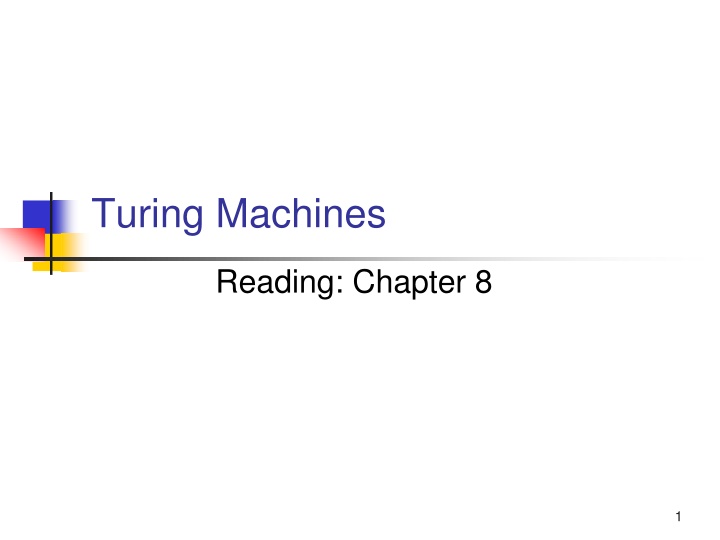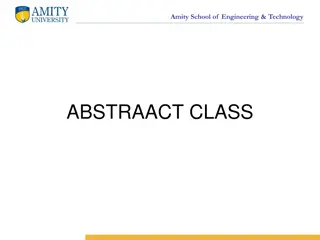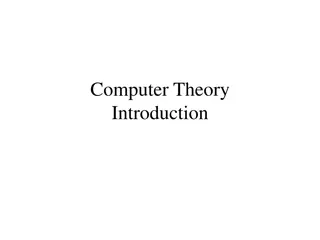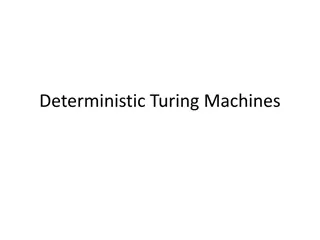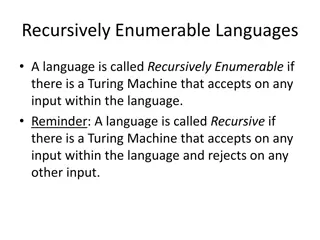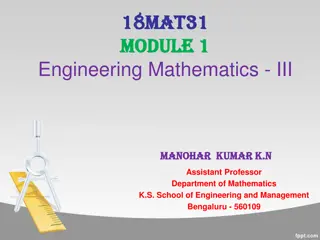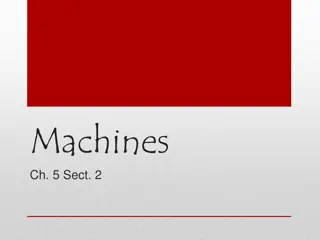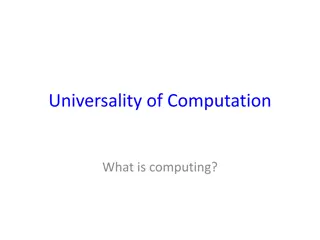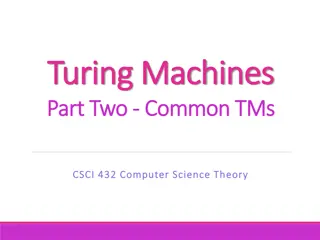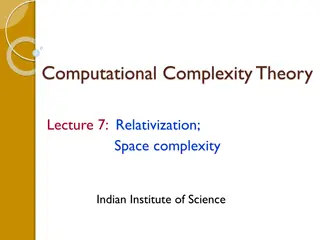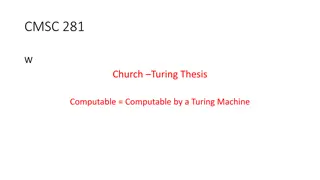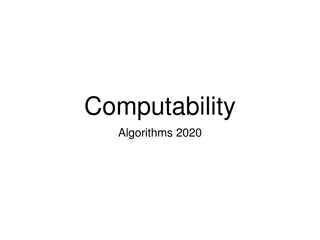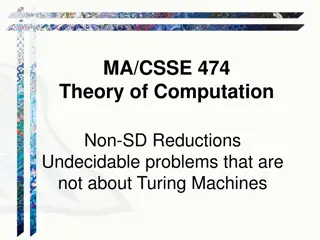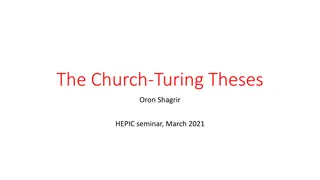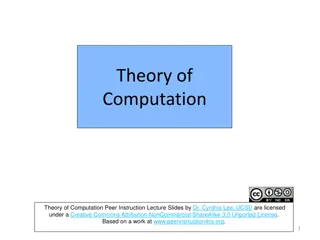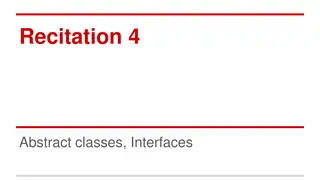Introduction to Turing Machines: A Powerful Abstract Concept
Turing Machines, as powerful abstract machines, can simulate modern computers albeit slowly. Their design aims to determine the decidability of problems, with undecidable problems implying computational limits. Explore TM components, transitions, and ID interpretations for computability assessment and problem-solving. Learn about membership verification and see an example of a Turing Machine applied to a specific language.
Uploaded on Apr 13, 2025 | 0 Views
Download Presentation

Please find below an Image/Link to download the presentation.
The content on the website is provided AS IS for your information and personal use only. It may not be sold, licensed, or shared on other websites without obtaining consent from the author.If you encounter any issues during the download, it is possible that the publisher has removed the file from their server.
You are allowed to download the files provided on this website for personal or commercial use, subject to the condition that they are used lawfully. All files are the property of their respective owners.
The content on the website is provided AS IS for your information and personal use only. It may not be sold, licensed, or shared on other websites without obtaining consent from the author.
E N D
Presentation Transcript
Turing Machines Reading: Chapter 8 1
Turing Machines are Very powerful (abstract) machines that could simulate any modern day computer (although very, very slowly!) For every input, answer YES or NO Why design such a machine? If a problem cannot be solved even using a TM, then it implies that the problem is undecidable Computability vs. Decidability 2
A Turing Machine (TM) This is like the CPU & program counter M = (Q, , , , q0,B,F) Finite control Tape is the memory Tape head Infinite tape with tape symbols B B B X1 X2 X3 Xi Xn B B Input & output tape symbols B: blank symbol (special symbol reserved to indicate data boundary) 3
You can also use: for R for L Transition function One move (denoted by |---) in a TM does the following: (q,X) = (p,Y,D) q is the current state X is the current tape symbol pointed by tape head State changes from q to p After the move: X is replaced with symbol Y If D= L , the tape head moves left by one position. Alternatively, if D= R the tape head moves right by one position. X / Y,D q p 4
ID of a TM Instantaneous Description or ID : X1X2 Xi-1qXiXi+1 Xn means: q is the current state Tape head is pointing to Xi X1X2 Xi-1XiXi+1 Xn are the current tape symbols (q,Xi) = (p,Y,R) is same as: X1 Xi-1qXi Xn|---- X1 Xi-1YpXi+1 Xn (q,Xi) = (p,Y,L) is same as: X1 Xi-1qXi Xn|---- X1 pXi-1YXi+1 Xn 5
Way to check for Membership Is a string w accepted by a TM? Initial condition: The (whole) input string w is present in TM, preceded and followed by infinite blank symbols Final acceptance: Accept w if TM enters final state and halts If TM halts and not final state, then reject 6
Example: L = {0n1n| n1} Strategy: w = 000111 B B X X 0 Y Y 1 B B B B 0 0 0 1 1 1 B B B B X 0 0 1 1 1 B B B B X X X Y Y 1 B B B B X 0 0 Y 1 1 B B B B X X X Y Y Y B B B B X X 0 Y 1 1 B B B B X X X Y Y Y B B Accept 7
TM for {0n1n| n1} Y / Y,R Mark next unread 0 with X and move right Move to the right all the way to the first unread 1, and mark it with Y Move back (to the left) all the way to the last marked X, and then move one position to the right If the next position is 0, then goto step 1. Else move all the way to the right to ensure there are no excess 1s. If not move right to the next blank symbol and stop & accept. 1. 0 / 0,R 2. 0 / X,R q0 q1 3. 1 / Y,L Y / Y,R X / X,R q2 q3 4. Y / Y,R Y / Y,L 0 / 0,L B / B,R q4 8
*state diagram representation preferred TM for {0n1n| n 1} Next Tape Symbol Curr. State q0 0 1 X Y B (q1,X,R) - - (q3,Y,R) - q1 (q1,0,R) (q2,Y,L) - (q1,Y,R) - q2 (q2,0,L) - (q0,X,R) (q2,Y,L) - q3 - - - (q3,Y,R) (q4,B,R) *q4 - -- - - - Table representation of the state diagram 9
TMs for calculations TMs can also be used for calculating values Like arithmetic computations Eg., addition, subtraction, multiplication, etc. 10
Example 2: monus subtraction m -- n = max{m-n,0} 0m10n For every 0 on the left (mark X), mark off a 0 on the right (mark Y) Repeat process, until one of the following happens: // No more 0s remaining on the left of 1 Answer is 0, so flip all excess 0s on the right of 1 to Bs (and the 1 itself) and halt //No more 0s remaining on the right of 1 Answer is m-n, so simply halt after making 1 to B ...B 0m-n B.. (if m>n) ...BB B.. (otherwise) 1. Give state diagram 2. 1. 2. 11
Example 3: Multiplication 0m10n1 (input), 0mn1 (output) Pseudocode: Move tape head back & forth such that for every 0 seen in 0m, write n 0s to the right of the last delimiting 1 Once written, that zero is changed to B to get marked as finished After completing on all m 0s, make the remaining n 0s and 1s also as Bs 1. Give state diagram 2. 3. 12
Calculations vs. Languages The language for a certain calculation is the set of strings of the form <input, output> , where the output corresponds to a valid calculated value for the input A calculation is one that takes an input and outputs a value (or values) A language is a set of strings that meet certain criteria E.g., The language Ladd for the addition operation <0#0,0> <0#1,1> <2#4,6> Membership question == verifying a solution e.g., is <15#12,27> a member of Ladd ? 13
Language of the Turing Machines Recursive Enumerable (RE) language Context- Regular (DFA) Enumerable sensitive Recursively Context free (PDA) 14
Generic description Will work for both a=0 and a=1 TMs with storage E.g., TM for 01* + 10* Current Storage symbol Tape symbol Next state Current state New Storage symbol Transition function : q storage ([q0,B],a) = ([q1,a], a, R) Tape head ([q1,a],a) = ([q1,a], a, R) B B 0 1 1 1 1 1 B B ([q1,a],B) = ([q2,B], B, R) Yes Are the standard TMs equivalent to TMs with storage? [q,a]: where q is current state, a is the symbol in storage 16
Multi-track Turing Machines TM with multiple tracks, but just one unified tape head control One tape head to read k symbols from the k tracks at one step. Track 1 Track 2 Track k 18
Multi-Track TMs TM with multiple tracks but just one head but w/o modifying original input string E.g., TM for {wcw | w {0,1}* } AFTER BEFORE control control Tape head Tape head B B 0 1 0 c 0 1 0 B Track 1 B B 0 1 0 c 0 1 0 B Track 1 B B B B B B B B B B Track 2 B B X X X c Y Y Y B Track 2 19 Second track mainly used as a scratch space for marking
Multi-tape Turing Machines TM with multiple tapes, each tape with a separate head Each head can move independently of the others control k separate heads Tape 1 Tape 2 Tape k 22
Non-deterministic TMs Deterministic TMs Non-deterministic TMs A TM can have non-deterministic moves: (q,X) = { (q1,Y1,D1), (q2,Y2,D2), } Simulation using a multitape deterministic TM: Control Input tape ID1 * ID2 * ID3 * ID4 * Marker tape Scratch tape 26
Summary TMs == Recursively Enumerable languages TMs can be used as both: Language recognizers Calculators/computers Basic TM is equivalent to all the below: TM + storage Multi-track TM Multi-tape TM Non-deterministic TM TMs are like universal computing machines with unbounded storage 1. 2. 3. 4. 27
